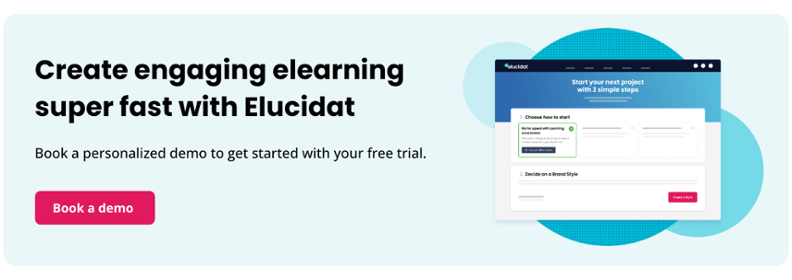Corporate elearning solutions for your business
10 minute read
Learning and development (L&D) is critical to the success of any organization. If you’re going to stay competitive and grow your business, your employees need the right knowledge and skills. But finding an effective way to achieve this at speed and scale isn’t easy, hence, there is an increasing need for bespoke elearning providers. Read on to find out how corporate elearning solutions can help.

What are corporate elearning solutions?
Before diving into why corporate elearning solutions should be part of your L&D strategy, let’s get clear on what we mean. Corporate elearning solutions are digital training programs that provide employees with online learning and development opportunities. These programs aim to equip employees with the knowledge and skills to excel at work and contribute to the success of the business.
A corporate elearning solution can include a wide variety of digital assets – from simple pdf checklists and selfie videos to more complex interactive webinars and online courses. These digital formats can be mixed and matched to meet the learning objectives of the program. They can also integrate with face-to-face learning formats, such as instructor-led training, mentoring, and on-the-job coaching.
Why you should opt for corporate elearning solutions
Corporate training can come in a variety of shapes and sizes. So, why would you opt for an elearning solution rather than more traditional face-to-face corporate learning formats?
Reasons for business giants
Larger businesses have more complex processes, a wider range of skills requirements and a bigger workforce. Their employees are often located across regions and countries. Working at this large, global scale means keeping up with changing markets, employee needs, and a variety of laws and regulations. And all while providing the consistently great products and services that customers expect.
In this context, training needs to work at speed and scale. Although L&D resources may be less limited than in smaller organizations, they need to achieve a lot. Corporate elearning programs provide a cost-effective, flexible approach to delivering consistent and relevant learning experiences.
Reasons for small businesses
Smaller organizations have less employees and often take on multiple roles and a wide variety of tasks. This means limited L&D budgets need to go even further towards effectively training their employees.
Mentoring from more experienced employees is a great way to upskill staff. But what happens when those experienced colleagues move on? By developing online learning in-house, smaller enterprises can ensure their business’ expertise is captured and critical skill gaps are avoided.
Benefits of corporate elearning solutions
Whether you’re a larger organization or a smaller enterprise, embracing digital learning can help your business succeed.
Here are our top 5 benefits of developing corporate elearning solutions:
- Responsive: 87% of businesses expect to face skill gaps within a few years. By developing elearning solutions inhouse with an authoring tool, you can respond as and when new employee development needs appear.
- Convenient: Employees can log on and complete digital learning at their own pace – wherever and whenever, including on their mobile devices. Easy to fit around other work, digital learning reduces the time employees spend away from their everyday duties for training.
- Cost-effective: Developing elearning solutions will pay off. It reduces your need for more expensive face-to-face courses, so you can use them where they have most impact. And, when elearning is effective (more on this later), every minute an employee spends training is time well-spent.
- Empowering: Online training makes it easier for employees to take responsibility for their own development. Providing a range of online training means they can personalize their learning experience. If an employee feels that they have a skill gap, they can identify, access, and complete elearning as and when they feel they need it.
- Managed and monitored: With a Learning Management Systems (LMS), you can easily manage and monitor the roll out of elearning to large numbers of employees. This can be achieved across locations, sectors and departments, all in real time. This means you can continually improve your performance.
How to deliver effective corporate training
It’s clear that digital learning can deliver plenty of benefits. However, with 43% of L&D professionals struggling to respond at speed, while maintaining quality, this isn’t always happening.
So, how do you deliver effective elearning that meets your end users’ needs and business goals?
Here are 4 key principles for impactful digital learning solutions.
- Make it relevant
The purpose of training is to help people do their jobs better. So, it’s not surprising that 62% of learners say relevant content is most important when it comes to effective elearning.
If something is useful, people will want to use it. That’s why it’s crucial to move away from generic learning materials and shift to content that meets your employee’s development needs.
- Get truly interactive
From targets to deadlines, lots of things are vying for your workforce’s attention. If learning is going to be effective, you need to grab their interest and keep it.
With 20% of learners switching off when elearning lacks interactivity, people clearly want more than just an online manual to read. When you take a closer look at what they mean by interactivity, it isn’t about clicking on the screen. It’s about engaging learners by creating connections and active participation. Using blended learning is also a great way to keep your employees engaged.
- Keep it concise
As well as being easier for busy employees to fit around their schedules, bite-sized digital learning content has more impact. 17% of learners said they were more engaged when elearning was concise, easy to understand, and well-organized. Whether that’s in 2 or 10 minutes, solutions that deliver real impact are a good use of learners’ time.
- Ensure it’s easy to access
The vast majority of people prefer learning on the job where they can immediately apply it. 22% of learners said their engagement increased when elearning was easy to access at work. Learning needs to be easy to complete and apply in those moments of need. That means making it practical – learning through observing, reflecting and trying.
You can find out more about how you can deliver effective digital learning, in our ultimate guide to designing quality elearning.
Choosing the best corporate elearning solution for you
Although there are some key principles for creating effective elearning solutions, there isn’t just one way to approach it. And there’s certainly no shortage of great tools and technology that can help you deliver it.
With such a wide range of options to choose from, where should you start?
Here are five steps to help you identify the best elearning solutions for your business.
Step 1: Understand your business’ requirements
The current learning trend or latest tech might sound exciting, but is it really right for your business? Before you get carried away with a potential solution, it’s always worth taking the time to get clear on your key requirements.
Here are some things to consider:
- Audience: Think about your learners and the type of training you need to deliver. For example, what are your key learning objectives? Do you need onboarding, compliance or soft skills training?
- Scale: Consider the quantity of the digital learning content you’re aiming to produce in a given time-frame. Will you need to re-brand, re-version, translate and/or regularly update content?
- Team: Reflect on the skill, experience and availability of your team. How ready and able are they to deliver the learning approaches you’re considering? Will you need to upskill your team? Or do you need to bring in new skills and resources from outside your organization (e.g. contractors and agencies)?
- Budget: You’re likely to have a set budget, but what does it look like to use that budget well? There isn’t just one way to think about providing value for money or return on investment (ROI). Identify the data you hold and how you can use it to show the impact of a new corporate elearning solution.
Step 2: Focus on important features
Based on your understanding of your organization’s training needs, you can define your preferred learning methodologies. Explore some expert corporate learning examples of digital learning approaches to get you inspired.
Next, identify the priority features you would need to deliver these approaches using an elearning platform or authoring tool. For example, is your focus going to be ease of use or custom functionality? Will you make use of templates and ready-made projects or start from scratch? Are you looking to create great mobile learning or is the desktop learning experience more important for your employees?
Step 3: Evaluate each tool
Do some high-level research to identify tools that appear to meet your specific needs. Evaluate each of these. Create a short list of the learning platforms that you think could work for your organization and your chosen learning approaches.
Next, dig a little deeper and see what people are saying about these tools:
- Reviews: Trusted sites, like eLearning Industry, provide unbiased reviews of tools on the market.
- Comparisons: Standalone reviews are helpful, but what if you’ve narrowed things down to a few tools. Comparison articles are a great way to directly compare platforms.
- Testimonials: Most authoring tool websites will include customer testimonials. These will cover their experience of the tool and partnering with the vendor.
Go deeper still and explore the people and services behind the tools. Ask for a demo so you can see authoring tools in action. Ask lots of questions of the customer success or support contact who is demoing the tool. Sign up for free trials so you can try the tools for yourself.
Step 4: Choosing your tool(s)
Finally, it’s time to do a comparison. If you’ve got two or three platforms that meet the same needs, take another look at those reviews. Weigh up the value for money and ROI they could offer.
Share your decision with colleagues and stakeholders for feedback on your decision.
The best corporate elearning solutions providers to choose from
Before making a decision, it’s important to understand all your options and review any possible candidates. So, here’s an overview of some of the best platforms designed to create, host, and/or deliver digital training courses and other learning materials.
Tools for creating elearning content
Elearning authoring tools are pieces of training and development software that enable the creation of digital learning content. Here are 12 top corporate elearning tools you could consider:
- Elucidat – Helps you create engaging and personalized learning content by unlocking expertise from any employee.
- Adobe Captivate – Gives experienced authors the power to create high-quality content.
- Articulate Storyline 360 – Ideal for individual users who prefer PowerPoint, with an added layer of customization.
- Articulate Rise 360 – Users with access to Articulate 360 can produce simple elearning courses fairly quickly.
- Gomo – Best for experienced instructional designers that aren’t looking for advanced customization.
- Lectora – Gives traditional, capable authors an effective tool for producing HTML5 content.
- Adapt – Designed for technical authors who are looking to design bespoke HTML5 authoring through back-end design.
- DominKnow – Perfect for teams whose focus is on responsive screen capture and software simulation.
- Easygenerator – Authoring software designed for learning teams who need to create elearning content, easily.
- iSpring Suite – Desktop PowerPoint-based tool that’s a great option for novice learning designers who don’t have to worry about updating content regularly.
- Evolve – Built for teams who need to collaborate together and don’t mind putting in the time to learn how to use it.
- Camtasia – Video editing suite most commonly used for screen recordings, tutorials or product demos.
Want to take a deeper dive into these tools? Read our full elearning authoring tool reviews.

Platforms for delivering corporate elearning solutions
Once you’ve created your elearning content, you need to deliver it to your employees. There are three types of elearning platform that can help you do this:
- Learning Management Systems (LMSs)
- Learning Content Management Systems (LCMSs)
- Learning Experience Platforms (LXPs)
Learning Management System (LMS)
A corporate LMS allows you to host, deliver and track digital learning, alongside other learning experiences.
Top examples:
- LearnUpon – A customer-centric learning management tool with an easy-to-use interface.
- Docebo – An LMS platform combining innovative tech and methods to support different learning styles.
Learning Content Management System (LCMS)
An LCMS is a one-stop-shop for creating, hosting, managing, and delivering content. It combines the functions of an LMS with those of a content management system (CMS).
Top examples:
- EdApp – An all-in-one corporate training solution and LCMS that includes a creator tool, admin and learning portal, analytics suite, and editable course library.
- Xyleme – A comprehensive elearning platform and LCMS bringing the elearning content development and management lifecycle together in a streamlined process.
Learning Experience Platform (LXP)
An LXP hosts training content for learners but, instead of L&D teams assigning content, the learner selects and accesses content by discovering it for themselves.
Top example:
- Valamis – An elearning platform and LXP that provides end-to-end elearning capabilities for learning creation, management and delivery.
Want to find out more about these elearning platforms? Read our full online elearning platform review.
Summary
Your employees are your biggest and most valuable business expense. Leaving their skills development to chance makes your organization vulnerable. An effective L&D strategy, which includes corporate learning solutions, is critical. From empowering your people to increasing your speed to train, the benefits of these digital solutions are many. But if you’re going to maximize your impact, you need the right learning approaches and tools for your organization.
Using Elucidat for your employee training
Elucidat’s powerful authoring platform empowers new and experienced authors to create impactful elearning. As a multi-award winning authoring tool, Elucidat makes it easier for you to deliver digital learning at scale, helping your business to respond to change faster.
If you’re interested in how Elucidat can help you produce and deliver high impact learning experiences affordably and at scale, book a personalized online demo to get started with a free trial.




